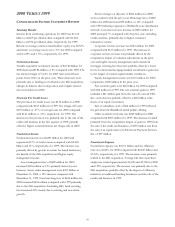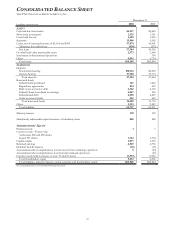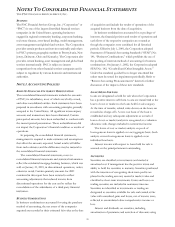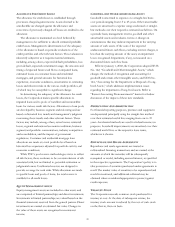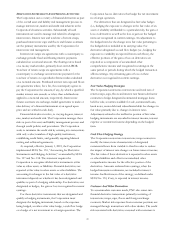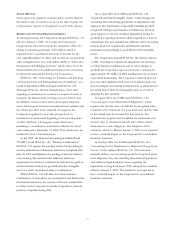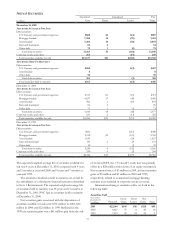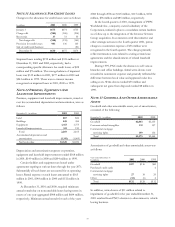PNC Bank 2001 Annual Report Download - page 70
Download and view the complete annual report
Please find page 70 of the 2001 PNC Bank annual report below. You can navigate through the pages in the report by either clicking on the pages listed below, or by using the keyword search tool below to find specific information within the annual report.68
ALLOWANCE FOR CREDIT LOSSES
The allowance for credit losses is established through
provisions charged against income. Loans deemed to be
uncollectible are charged against the allowance and
recoveries of previously charged-off loans are credited to the
allowance.
The allowance is maintained at a level believed by
management to be sufficient to absorb estimated probable
credit losses. Management’s determination of the adequacy
of the allowance is based on periodic evaluations of the
credit portfolio and other relevant factors. This evaluation is
inherently subjective as it requires material estimates,
including, among others, expected default probabilities, loss
given default, expected commitment usage, the amounts and
timing of expected future cash flows on impaired loans,
estimated losses on consumer loans and residential
mortgages, and general amounts for historical loss
experience, economic conditions, uncertainties in estimating
losses and inherent risks in the various credit portfolios, all
of which may be susceptible to significant change.
In determining the adequacy of the allowance for credit
losses, the Corporation makes specific allocations to
impaired loans and to pools of watchlist and nonwatchlist
loans for various credit risk factors. Allocations to loan pools
are developed by business segment and risk rating and are
based on historical loss trends and management’s judgment
concerning those trends and other relevant factors. These
factors may include, among others, actual versus estimated
losses, regional and national economic conditions, business
segment and portfolio concentrations, industry competition
and consolidation, and the impact of government
regulations. Consumer and residential mortgage loan
allocations are made at a total portfolio level based on
historical loss experience adjusted for portfolio activity and
economic conditions.
While PNC’s pool reserve methodologies strive to reflect
all risk factors, there continues to be a certain element of risk
associated with, but not limited to, potential estimation or
judgmental errors. Unallocated reserves are designed to
provide coverage for such risks. While allocations are made
to specific loans and pools of loans, the total reserve is
available for all credit losses.
EQUITY MANAGEMENT ASSETS
Equity management assets are included in other assets and
are comprised of limited partnerships and direct investments.
Investments in limited partnerships are valued based on the
financial statements received from the general partner. Direct
investments are carried at estimated fair value. Changes in
the value of these assets are recognized in noninterest
income.
GOODWILL AND OTHER AMORTIZABLE ASSETS
Goodwill is amortized to expense on a straight-line basis
over periods ranging from 15 to 25 years. Other amortizable
assets are amortized to expense using accelerated or straight-
line methods over their respective estimated useful lives. On
a periodic basis, management reviews goodwill and other
amortizable assets and evaluates events or changes in
circumstances that may indicate impairment in the carrying
amount of such assets. If the sum of the expected
undiscounted future cash flows, excluding interest charges, is
less than the carrying amount of the asset, an impairment
loss is recognized. Impairment, if any, is measured on a
discounted future cash flow basis.
Effective January 1, 2002, the Corporation adopted SFAS
No. 142, “Goodwill and Other Intangible Assets,” which
changes the method of recognition and accounting for
goodwill and certain other intangible assets, and SFAS No.
144, “Accounting for the Impairment or Disposal of Long-
lived Assets,” which addresses implementation issues
regarding the impairment of long-lived assets. Refer to
“Recent Accounting Pronouncements” herein for further
discussion of the impact of these new standards.
DEPRECIATION AND AMORTIZATION
For financial reporting purposes, premises and equipment
are depreciated principally using the straight-line method
over their estimated useful lives ranging from one to 39
years. Accelerated methods are used for federal income tax
purposes. Leasehold improvements are amortized over their
estimated useful lives or the respective lease terms,
whichever is shorter.
REPURCHASE AND RESALE AGREEMENTS
Repurchase and resale agreements are treated as
collateralized financing transactions and are carried at the
amounts at which the securities will be subsequently
reacquired or resold, including accrued interest, as specified
in the respective agreements. The Corporation’s policy is to
take possession of securities purchased under agreements to
resell. The market value of securities to be repurchased and
resold is monitored, and additional collateral may be
obtained where considered appropriate to protect against
credit exposure.
TREASURY STOCK
The Corporation records common stock purchased for
treasury at cost. At the date of subsequent reissue, the
treasury stock account is reduced by the cost of such stock
on the first-in, first-out basis.


